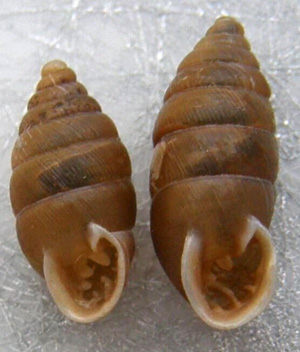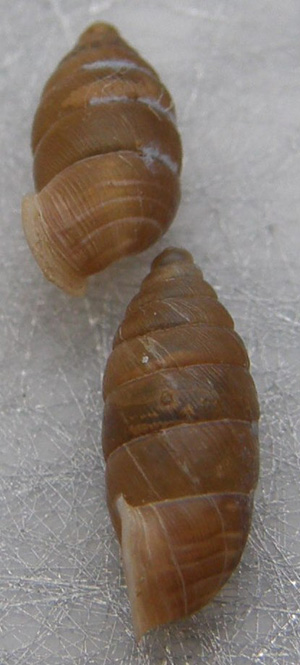|
On June 12, 2009 whilst on a visit to St Agnes, as part of a visit to the Scilly Islands by the Lakeland Horticultural Society, Barry Colville collected two freshly dead specimens of Granaria frumentum illyrica (Rossmässler, 1837) from under a mat of red fescue grass Festuca rubra, in a sheltered south-facing bay formed on St Agnes by its bar connecting it to Gough (NGR SV886083). The site is only a few feet above sea-level and the ground cover has trapped small quantities of sand within its surface structure. Geologically the Islands are granite with a mild oceanic climate. The coastal granite rock outcrops are one of the most important habitats for lichens. Over most of the island the granite is covered by mainly superficial deposits which are acidic in character. Thus any lime requirements of land snails must rely on the presence of lime within the shell-sands present at the site. The specimens were firstly forwarded to me (A.N.) and subsequently sent on to Dr Edmund Gittenberger at Leiden Museum who made the following observations: "The Granaria frumentum-illyrica group is still poorly understood. In northern Italy, for example near Lake Garda, illyrica can be very large, whereas in northernmost Greece the shells are much smaller, like frumentum, but more slender and without any conspicuous radial swelling at the outside behind the apertural lip. From southern Austria I know rare forms that are in between ‘typical’ frumentum and illyrica. The species name is somewhat more problematic, since frumentum and illyrica may be considered conspecific subspecies (Gittenberger pers. comm.). On the continent both are getting increasingly rare. If the specimens found on St Agnes are an introduced form of G. frumentum, their origin is problematic. They are not from the range of G. frumentum frumentum. However, from what I have read about the Scilly Islands nothing immediately excludes the possibility that the snails do in fact belong there! Even if more specimens could be found it may be difficult to interpret this find. Anatomical data is limited due to the fact that the G. frumentum group has hardly been investigated anatomically. In order to compare data on the genital apparatus within and between populations of this widespread and variable species a large number of living samples would be required from across Europe. However, some unpublished DNA data is available and so it might be possible to investigate which are the closest related populations (closest to a sample in the sequenced material). So a piece of tissue collected from the site on St Agnes, could in principle, tell us a little more about its status." The specimens found by Barry Colville are small, but not slender, prominently sculptured with no trace of the transverse thickening behind the apertural lip (see Kerney & Cameron, page 82.). Also all four palatal-basal lamellae reach the lip in the specimens collected on St Agnes. |
Photos: Adrian Norris |
The Discovery of Granaria frumentum illyrica (Rossmässler, 1837) on the Isles of Scilly
Issue
23
Page
5


